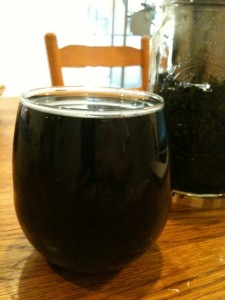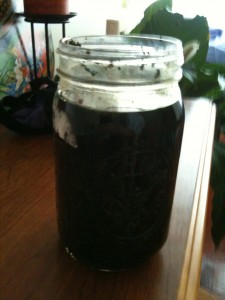(Don’t get me wrong. I love green smoothies.)
I’ve got a little pipe dream that nourishing herbal infusions might enjoy the widespread popularity that
green smoothies have attained. You might say that I’ve got a little bit of an herbal chip on my shoulder. See, there are so many health-minded people who will happily drink some crazy smoothies but who haven’t yet gotten cozy with herbal medicine. When most folks want to try a natural remedy, they still head to the health food store and buy a bottle of tablets or capsules containing processed vitamins, minerals, or herbal extracts. There’s nothing inherently wrong with that—but homemade remedies are like homemade food. They’ll beat a mass-produced version on taste, nourishment, and cost-effectiveness every time.
Today I want to turn you on to a much simpler way of getting more vitamins & minerals into your daily diet. This is a widely-known practice in the herbal medicine world that’s been passed down to us through Juliette de Barclay-Levi and then Susun Weed. I’m not inventing anything new here, but I hope that I can start bringing this practice into the mainstream where it belongs.
Nourishing infusions:
- are easy to assimilate because the goodies are already extracted for you in water. No more undigested vitamin pills in the toilet. (It happens more often that you’d think.)
- couldn’t be simpler to make. You just put your herbs in a mason jar, pour boiling water over them, let them sit overnight, strain & drink.
- are made with herbs that are more food-like than drug-like. They’re very safe & make a great introduction to herbal medicine.
- make a noticeable difference in your health when you use them regularly.
There are dozens of herbs that make terrific nourishing infusions, but the one that I love to introduce people to first is Stinging Nettle (Urtica dioica.) It has a lovely flavor that’s deep and rich but not at all bitter, and it’s loaded with nutrients including calcium, magnesium, iron, Vitamin C, Vitamin K, and more.
Herbs are more than the sum of their component nutrients. Stinging nettle is so strengthening to our bodies not only because of the nutrients it contains that can be measured in a lab & absorbed by your body, but also because of it’s ‘personality.’ This is a tough plant, often thought of as a weed. It grows without human tending in fields and ditches and thrives in places where many plants can’t get a foothold. It defends itself with stingers, staking a claim to its place in the world.
The real beauty of herbal medicine is that you can begin to have a relationship with the plants. Traditional cultures recognize that the plants are our brothers & sisters, that we share this planet of ours and that we need each other. Something changed in my life when I began experiencing plants this way. When you start drinking nettle infusions, picture this scrappy little plant digging into difficult ground and growing up tall and strong in less-than-ideal circumstances. The physical nutrients are only half of the medicine. Sounds hard to believe? Don’t take my word for it. Try drinking nettle infusion 5 days per week for a month and observe your own experiences. My guess is that you’ll notice a strength that goes beyond what you’d get out of a vitamin pill. And for some of you, your intuitive connection with plant medicine may be strong enough that it propels you into further study and experimentation.
Here’s how to make Stinging Nettle Infusion.

a great morning pick-me-up
You’ll need:
1 oz of dried Stinging Nettle
1 qt Mason Jar
Filtered water
Cheesecloth, or a strainer
Directions:
1. Put 1 oz of dried nettle (cut & sifted…the leaves will be about the size of dried basil) into the empty Mason jar.
2. Put 1 qt of filtered water in a teakettle and bring up to the boil.
3. Pour the water over the dried nettles.
4. Leave to steep for at least 4 hours, or overnight. Strain.
5. Drink within 24hrs. Keep in the fridge if you can’t drink it all at once. If you have any leftovers after 24hrs, you can use it as a hair rinse or to water your plants. (Plants LOVE nettle infusion.)
Want to read more about nettles? Read about Gena’s experience trying them here.

